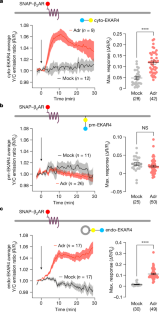2022-10-26 パデュー大学
ある種のツボカビは生物多様性の弊害となっている。ツボカビの1種は、両生類の大量死や絶滅の原因となっているのだ。
二倍体の生物は、それぞれの親から受け継いだ2組の染色体を持ち、ほとんどの場合、減数分裂によって生殖する。減数分裂により、ヒトでは精子と卵子のような2つのハプロイド配偶子が作られ、これが融合して新しい二倍体生物となる。
真菌類界における複雑性の増大という主要な仮定の多くが、真実ではないことを発見した。これらの生物は有糸分裂によって繁殖していましたが、常に半数体だったわけではなく、中には二倍体のものもあった。
菌類学者たちは、高等真菌類はまずハプロイドから始まり、やがてディプロイドを生み出すようになったと理論付けました。
<関連情報>
- https://www.purdue.edu/newsroom/releases/2022/Q4/research-into-ancient-lineage-of-microscopic-fungi-upends-assumptions-about-its-genetic-relationships.html
- https://www.pnas.org/doi/10.1073/pnas.2116841119
菌類の初期進化を特徴づける二倍体優位のライフサイクル Diploid-dominant life cycles characterize the early evolution of Fungi
Kevin R. Amses, D. Rabern Simmons Joyce E. Longcore Stephen J. Mondo, Kensuke Seto, Gustavo H. Jerônimo Anne E. Bonds, C. Alisha Quandt William J. Davis Ying Chang, Brian A. Federici Alan Kuo Kurt LaButti Jasmyn Pangilinan, William Andreopoulos Andrew Tritt Robert Riley, Hope Hundley Jenifer Johnson, Anna Lipzen, Kerrie Barry, B. Franz Lang Christina A. Cuomo Nicolas E. Buchler Igor V. Grigoriev Joseph W. Spatafora, Jason E. Stajich and Timothy Y. James
Proceedings of the National Academy of Sciences Published;August 29, 2022
DOI:https://doi.org/10.1073/pnas.2116841119

Significance
It has been assumed that fungi are characterized by a haploid-dominant life cycle with a general absence of mitosis in the diploid stage (haplontic life cycles). However, this characterization is based largely on information for Dikarya, a group of fungi that contains mushrooms, lichens, molds, yeasts, and most described fungi. We now appreciate that most early-diverging lineages of fungi are not Dikarya and share traits with protists, such as flagellated life stages. Here, we generated an improved phylogeny of the fungi by generating genome sequences of 69 zoosporic fungi. We show, using the estimated heterozygosity of these genomes, that many fungal lineages have diploid-dominant life cycles (diplontic). This finding forces us to rethink the early evolution of the fungal cell.
Abstract
Most of the described species in kingdom Fungi are contained in two phyla, the Ascomycota and the Basidiomycota (subkingdom Dikarya). As a result, our understanding of the biology of the kingdom is heavily influenced by traits observed in Dikarya, such as aerial spore dispersal and life cycles dominated by mitosis of haploid nuclei. We now appreciate that Fungi comprises numerous phylum-level lineages in addition to those of Dikarya, but the phylogeny and genetic characteristics of most of these lineages are poorly understood due to limited genome sampling. Here, we addressed major evolutionary trends in the non-Dikarya fungi by phylogenomic analysis of 69 newly generated draft genome sequences of the zoosporic (flagellated) lineages of true fungi. Our phylogeny indicated five lineages of zoosporic fungi and placed Blastocladiomycota, which has an alternation of haploid and diploid generations, as branching closer to the Dikarya than to the Chytridiomyceta. Our estimates of heterozygosity based on genome sequence data indicate that the zoosporic lineages plus the Zoopagomycota are frequently characterized by diploid-dominant life cycles. We mapped additional traits, such as ancestral cell-cycle regulators, cell-membrane– and cell-wall–associated genes, and the use of the amino acid selenocysteine on the phylogeny and found that these ancestral traits that are shared with Metazoa have been subject to extensive parallel loss across zoosporic lineages. Together, our results indicate a gradual transition in the genetics and cell biology of fungi from their ancestor and caution against assuming that traits measured in Dikarya are typical of other fungal lineages.


